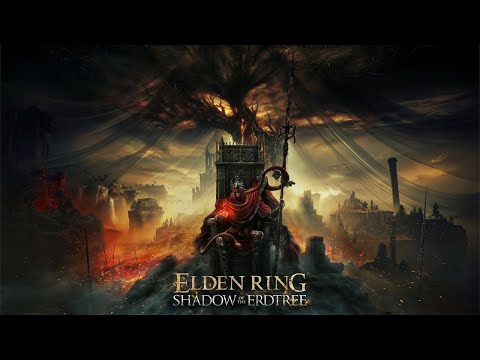[ad_1]
There was a time when Tomb Raider stood as one of the most recognisable game series in the world, but decades later the original entries are largely unknown to those that didn’t grow up with them. That’s where Tomb Raider 1-3 Remastered comes into play, a collection of brand-new versions of the first three titles with enhanced lighting, improved detail, high-res textures and better performance. Remastered feels both fresh and retro at the same time – and I’ve been playing it over the last week to determine how it stacks up against the original games in terms of visuals, controls and more.
Back in 2016, I created an episode of DF Retro covering the original Tomb Raider where I compared the PlayStation, Saturn and PC versions while showcasing some of the underlying technology in action, such as Sega Saturn’s unique sprite-driven 3D rendering. Since that video, the Tomb Raider scene has continued to thrive with the release of the open-source Tomb Raider engine OpenLara, not only showcasing impressive new visual feature features but also enabling the community to go wild with porting. There now exists, for instance, versions of Tomb Raider that can run on classic consoles like the Sega 32x, 3DO and Game Boy Advance.
The rebooted series itself has also gone on a hiatus of sorts, disappearing following the release of Shadow of the Tomb Raider as we await a new installment. In the here and now though, we have this brand-new re-release of the first three games thanks to Aspyr and, save for a few minor issues here and there, my experience has been excellent.
 Tomb Raider 1-3 Remastered – PlayStation/Xbox/PC/Steam Deck/Switch – Digital Foundry Tech Review
Tomb Raider 1-3 Remastered – PlayStation/Xbox/PC/Steam Deck/Switch – Digital Foundry Tech Review
The pitch is simple – this release seeks to deliver the first three Tomb Raider games with a range of optional enhancements. You can enjoy them with enhanced graphics or stick with the original assets. You can also play with the original “tank” controls or opt for a more modern full analogue system. The big selling point here really is the visual enhancements and, frankly, I think they’ve done a fantastic job. In order to retain the original Tomb Raider game design, the environments stick to the original geometry and layouts, but everything surrounding it has been updated.
The first thing you might notice are the brand-new high-resolution textures. They’ve managed to retain the look and feel of the original textures while adding detail that did not previously exist. You can instantly toggle between the enhanced and original graphics if you want to compare the two yourself at any point.
I like what they’ve done here – the textures strive to resemble the originals while layering in a tremendous amount of detail along the way. The remastered textures really channel the original aesthetic and colour of the original game in a way that looks really nice. It almost resembles a lost early 2000s game or something akin to installing the S3TC texture pack for Unreal Tournament, thanks to that combination of ultra-fine detail textures on simplistic surfaces.
Aspyr has also made changes to things like animated textures – the water, for instance, has been replaced with a new surface texture that I think generally looks pretty OK. It’s not on par with the rippling water and caustics available in OpenLara, unfortunately, but it perhaps gels better with the game’s visual style.
Overall, I do think they’ve done a nice job with the textures. There was discussion around using AI upscaling of its textures, however, which is something we’ve in similar remasters in the past. I’m not an expert in this area, but the key here is that the telltale signs of AI upscaling are minimised and the end result feels as if it were carefully adjusted by hand. This isn’t like the GTA remaster collection where obvious issues made their way into the assets – most textures here look sharp and manage to avoid the smudging and weirdness you get with AI upscaling.
The developers also deployed some really interesting tricks such as attempting to fake depth on ladders using parallax effects. It can look a little weird sometimes, but it’s a neat addition.

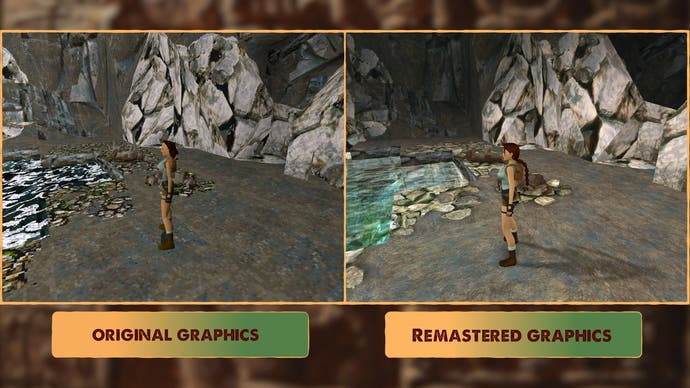
Beyond these changes though, the team has also layered in additional 3D models. The original games mostly used sprites or very low-poly scenery assets, so the remasters can look quite different – eg adding things like grass where there was none before. t’s done just tastefully enough so not as to overwhelm and I think it greatly improves the presentation.
Aspyr even went so far as to create high-res versions of the game’s various menus and videos, with AI upscaling seemingly being used for the video side. These look good enough, although there’s only so much you can do given the low resolution of the original clips. The menus are a more resounding success, offering an instant swap between original and remastered music, sound effects and visuals. You’re even able to scroll through recreated versions of the main menus from each of the three games by pressing up and down. That’s a great touch.
Another key improvement lies in the lighting. The original Tomb Raider uses a mix of static lighting and per-vertex lighting for dynamic objects. For 1996, it was a fast solution that produces a sense of light and darkness within the tombs themselves, but it has pretty serious limitations. With Remastered however, the developers seem to have implemented increasingly modern baked lighting into the levels, while perhaps using some sort of light probe system to allow contributions to dynamic objects.

As a result, the game not only more accurately portrays light and shadow, but also colour transfer. When you enter a room with predominately red features, you’ll notice a soft red glow on characters and throughout the room. We’re not looking at any fancy ray tracing features or anything, but this new pass of light looks excellent and fills the world with far more natural lighting that actually plays nicely with the simple geometric shapes.
The only caveat to this approach is that some areas that were overly and unrealistically lit now appear much darker due to the more realistic light behaviour. This can make it more difficult to navigate certain sections or find objects you might need. I didn’t struggle much with this myself, but new players might. At least the draw distance is expanded – you can now see much further away in every level.
The other major overhaul involves the characters, which all feature more detailed models that more closely resemble the first round of Crystal Dynamics developed Tomb Raider games. Even better, the real-time cutscenes now feature actual facial animation to match the dialog – which is something that was not true of the original versions where they simply used bobbing heads. While these visual upgrades may not appeal to everyone, I found that it strikes a nice balance between retro and modern that is very much appreciated. Crucially, level readability, aside from the occasional light issue, is key to the central design of Tomb Raider and is well reproduced here.
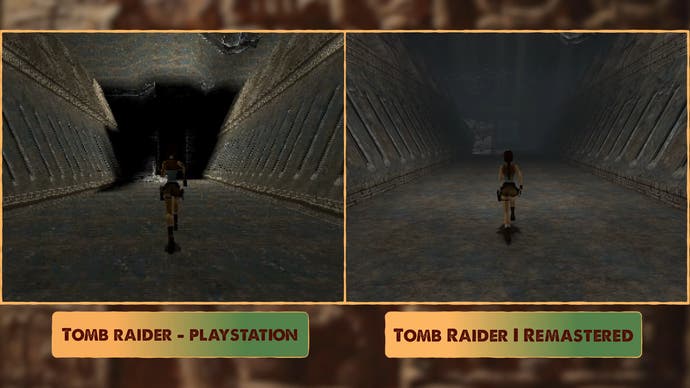
Now, the classic graphics mode in the Remastered release seems suitably retro at first glance, but in reality, it’s more of an idealised version of Tomb Raider. For instance, Tomb Raider for DOS running in software mode uses an eight-bit colour palette with lots of visible banding, not to mention texture warping and other issues. While it shares the same basic assets, it winds up looking very different than the classic graphics mode in Remastered – and the same is true for any of the 3D-accelerated versions too.
That’s why I feel the classic graphics mode in Tomb Raider Remastered represents a nice middle ground – it preserves the original assets but allows high-res rendering and an increased colour depth without using texture filtering which tends to look pretty ugly when applied to low-res textures.
Tomb Raider 1-3 Remastered is available on basically every current and last-generation platform. For this video, I tested the game on Xbox Series X and S, PS5, PC, Steam Deck and Switch but it also runs on Xbox One and PS4. I didn’t feel the need to test every single version, as this is a release where I feel that you can extrapolate from the results on other consoles and determine that everyone will have a solid experience.

What do I mean? Well, let’s consider the weakest system – Nintendo Switch. This one delivers either 1080p60 in docked mode or 720p60 in portable. It maxes out the system’s display options, basically, and it does so without breaking a sweat. In every situation, I encountered not even a single hiccup in frame-rate. Mind you, there’s always that possibility of a dip happening somewhere later in the game but, even if that’s the case, I’d argue we’re looking at near-flawless performance.
The more powerful consoles, such as Xbox Series X and PS5, also deliver the goods with a perfect native 4K 60fps output that’s razor-sharp and runs without any issues. Xbox Series S is well represented with a 1440p60 release too. In short, every console version I tested is sharp and stable – but there is one big caveat and that’s the classic mode.
Much like the originals, the classic mode caps itself to just 30fps and unfortunately presents with frame pacing issues as well. This makes the game look and feel jerky, with additional judder, on every console. I found this to be a huge bummer and one area where Remastered falls flat compared to OpenLara, which has no such limitations. Given this, I’d say classic mode basically demands a patch to get it up to snuff.
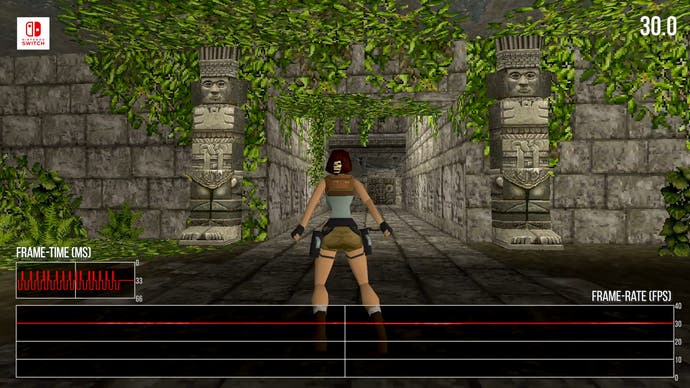
The PC version is perhaps even more interesting. As expected, requirements are very low and it supports hardware dating back to 2012 without issue. I’d imagine it could scale lower, but it seems to be a 64-bit application which raises those requirements slightly. However, there are a couple oddities which deserve mention here.
Firstly, there are zero graphics options in this game and I mean that. There is no option to change the resolution, no graphical settings, nothing – you start it up and it goes – that’s it. On paper, this is really bad, but in reality, it’s perhaps not a huge deal as it simply seems to target your current desktop res and refresh rate. If you’re at 4K120 on the desktop, that’s what you’ll get in-game, and the requirements are so low that you likely won’t need to adjust anything anyway.
The larger issue, however, ties into how the screen is drawn. When I first loaded it up, I was surprised at how jerky the visuals seemed to be. The frame-rate itself was high, but there was an intermittent judder that resulted in a noticeably less smooth experience compared to consoles. I tried a bunch of things before finally stumbling on the solution.
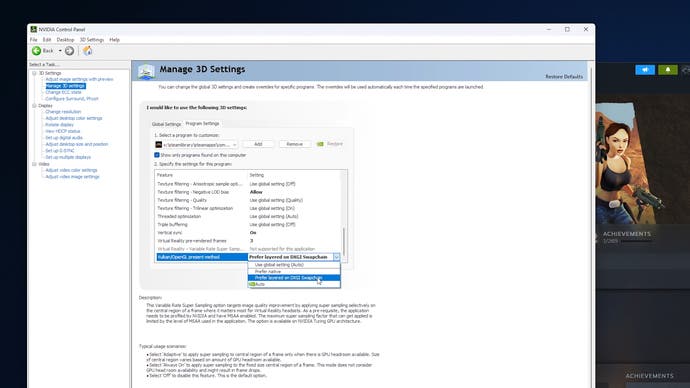
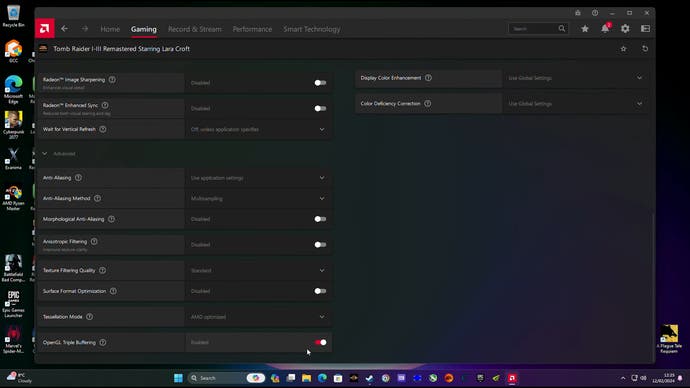
For Nvidia graphics card users, within the Nvidia Control Panel you need to select ‘Prefer Layered on DXGI Swapchain’ under the ‘Vulkan/OpenGL present method’ setting. In my case, enabling this solved the issue entirely and resulted in a completely smooth experience, but it’s clear this is something that no player would normally be expected to do and the vast majority of users wouldn’t even know such an option exists.
What about AMD and Intel users need to resort to a slightly less elegant solution – basically, you’ll need to force OpenGL triple buffering in your control panel. This cleans up most of the stutters, but not all – I still encountered minor frame-time hiccups in this case. Hopefully these workarounds can be replaced by an official fix in a future patch, since the PC version otherwise allows for much higher frame-rates than 60fps, which is a great feature.
I also feel like Tomb Raider weirdly plays best on a keyboard – the controls just feel right that way and this is the platform that I enjoyed playing on the most. It might sound strange, but give it a shot.
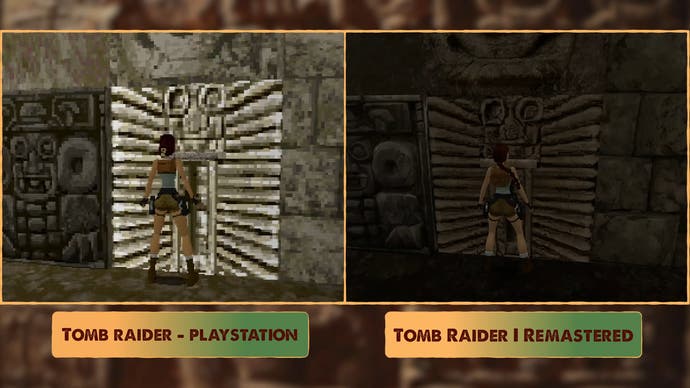
The game also runs excellently on Steam Deck, without the swapchain management glitches on PC. It even hits perfect frame-times and the full 90fps on the OLED model – making this an awesome platform for playing through these games.
So, when considering all the different versions then, I think Tomb Raider perfectly accomplishes what it sets out to deliver across the full range of consoles. The PC version is technically the best version, but only if you configure it correctly using your graphics card control panel.
Taking a step further back, it’s interesting to consider how Tomb Raider appears in the context of the modern era – after all, this was an extremely popular series back in the 90s, but playing it today I’m a little surprised that it was so widely enjoyed, given its steep challenge. Personally, after returning to Tomb Raider I found myself fully engaged in its gameplay in a way I didn’t expect. I knew that modern games had simplified things such as jumping and climbing but this really reminds me how much we’ve lost.
[ad_2]
Source link


